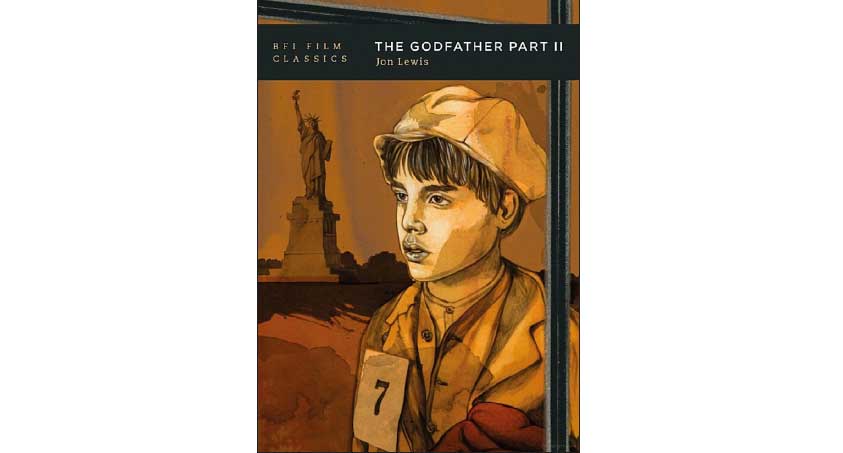Jon Lewis follows up his 2010 BFI Film Classics volume on Francis Ford Coppola’s The Godfather (1972) with an excellent second book of analysis focused on the film’s sequel: The Godfather, Part II (1974). In the introduction, Lewis positions Coppola as a figure who once possessed an immense power and influence within Hollywood, with The Godfather, Part II acting as a turning point for both the director and the New Hollywood movement more widely– a film that ‘made the case that an indulgence of an auteur theory … might actually work to the benefit of movie-makers and moneymen alike’ (8). This framing of Coppola is of particular interest given the director’s limited output over the past two decades, especially in light of his recent return to directing for the long-awaited passion project, Megalopolis, which has just entered production.
Following a brief historical overview of the aftermath of the first film’s release (outlining Marlon Brando’s controversial non-appearance at the 1973 Oscars and Coppola’s reluctance to direct a sequel), Lewis settles into a lengthy second chapter which comprises the bulk of the book, describing The Godfather, Part II as a ‘movie of meetings’ (17). Throughout this chapter, he makes a number of incisive observations about the film’s unique structural design and Coppola’s decision to move back-and-forth between the stories of Michael Corleone (Al Pacino) in 1950s America and his young father, Vito Andolini (Robert De Niro), in turn-of-the-century Sicily. The book makes a case for Part II as a standalone feature in its own right but Lewis is also keen to note the ways in which it mirrors events from The Godfather, often adding further layers of meaning to the sequel. Both begin with lengthy party sequences celebrating important milestones for the members of the Corleone family (a wedding and a confirmation, respectively). Both end with a series of murders demonstrating Michael’s ruthlessness. Lewis’ analysis pays close attention to the film’s detailed mise-en-scène, drawing the reader’s attention to small gestures in the film’s performances, the significance of certain musical cues and the effect of the flashback structure on the film’s pace. Most impressive is the way the book seamlessly moves between a close engagement with the film’s aesthetics and a recounting of the history of its production. This is evident following a lengthy section discussing Michael’s actions during the opening party sequence at Lake Tahoe, when Lewis writes, ‘Pacino’s performance here … proved crucial to establishing a continuity from the first film to the sequel. Pacino was always going to be vital to the sequel. But getting him on board proved difficult’ (24). Lewis then continues into a stretch of writing discussing the problems facing Coppola and the film during its pre-production period with regards to the casting of Pacino in Part II. These kinds of segues result in a book which is accessible for casual reading but filled with attention to detail and sharp analysis that is also likely to satisfy film scholars and academics.
Lewis also takes an interesting detour to focus on the oft-side-lined female characters featured in the macho world of Coppola’s crime series. He draws parallels between the way the film treats Michael’s older sister Connie (Talia Shire), excluding her character for long stretches, and Hollywood’s treatment of the Shire herself, noting that ‘[She] has over the years been dismissed as Francis’s sister, the successful movie music composer Michael Shire’s wife and after that the film producer Jack Schwartzman’s wife, Sofia Coppola and Nic Cage’s aunt, the actor Jason Schwartzman’s mother’ (71). It is one of the few moments in the book that borders on a negative critique of Coppola’s film and writing, re-emphasising its intense focus on Michael as a central figure around which everything else must revolve.
Michael is described by Lewis as ‘at once the most powerful and loneliest man in America’ (85) and, interestingly, framed as a figure whose values mean different things to contemporary viewers than those who saw the film upon its initial release. There are a number of links made to the political events which occurred in the decade preceding the film’s release and their echoes, which are present in various guises throughout Part II. For example, Hyman Roth’s murder is ‘staged and blocked to resemble Jack Ruby’s murder of Lee Harvey Oswald – a … reminder again of the persistent rumours concerning Mob involvement in the Kennedy assassination’ (81-82). The film was also released into what Lewis called a ‘deeply cynical post-Watergate zeitgeist, presaging the evolution of neo-liberalism, financialisation and globalisation’ (87). He believes today’s viewers often fail to recognise this critique in Coppola’s text and, citing Robert Warshow (1948), highlights that they should also be wary of Michael and should reject the idea of the gangster figure and ‘his unrelenting drive for success and the brutality that such success requires’ (86). Nowadays, Lewis instead often finds classes admiring Michael’s drive and authority, but concludes the book with that hope that the viewer ultimately realises that ‘we are not him, that we are not like him, no matter how much we think we might like to be’ (89)— a unique and anecdotal closing plea which speaks both to the film’s enduring appeal but also the necessity of a long-form close analysis such as this.
Competing Interests
The author has no competing interests to declare.
References
Lewis, J 2010 The Godfather. London: British Film Institute. DOI: http://doi.org/10.1007/978-1-349-92423-3
Lewis, J 2022 The Godfather, Part II. London: Bloomsbury. DOI: http://doi.org/10.5040/9781839023293
Warshow, R 1948 The Gangster as Tragic Hero. Partisan Review, pp. 240–244.
Filmography
The Godfather, 1972. [Film] Francis Ford Coppola. USA: Paramount Pictures.
The Godfather, Part II, 1974. [Film] Francis Ford Coppola. USA: Paramount Pictures.
Megalopolis, TBC. [Film] Francis Ford Coppola. USA: American Zoetrope.
